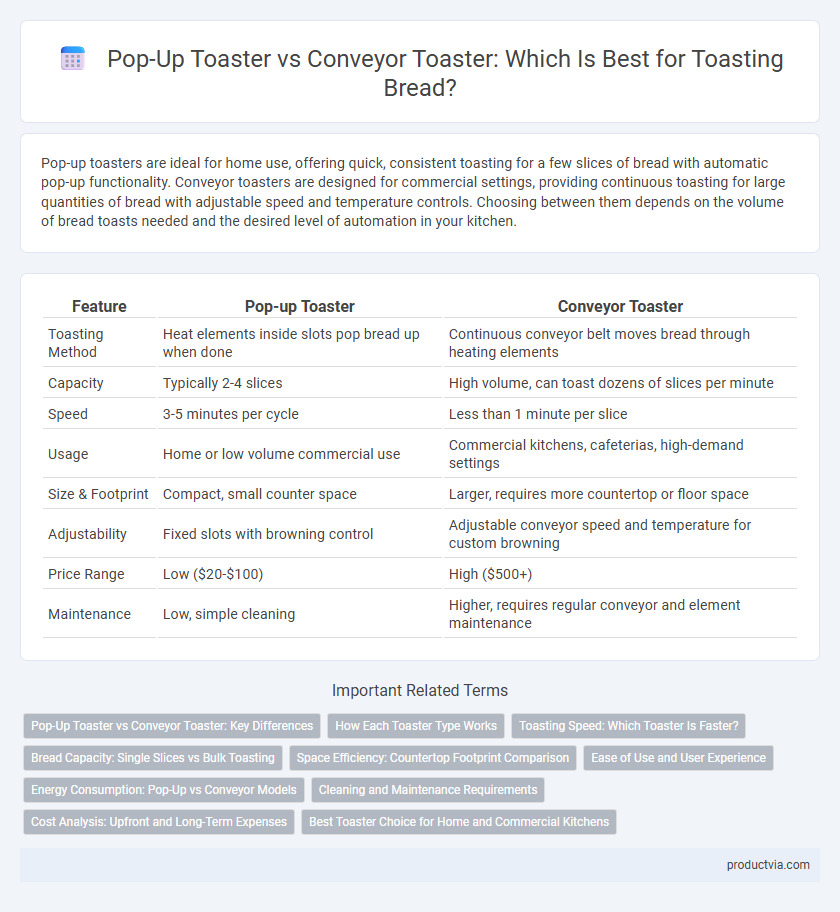Pop-up toasters are ideal for home use, offering quick, consistent toasting for a few slices of bread with automatic pop-up functionality. Conveyor toasters are designed for commercial settings, providing continuous toasting for large quantities of bread with adjustable speed and temperature controls. Choosing between them depends on the volume of bread toasts needed and the desired level of automation in your kitchen.
Table of Comparison
| Feature | Pop-up Toaster | Conveyor Toaster |
|---|---|---|
| Toasting Method | Heat elements inside slots pop bread up when done | Continuous conveyor belt moves bread through heating elements |
| Capacity | Typically 2-4 slices | High volume, can toast dozens of slices per minute |
| Speed | 3-5 minutes per cycle | Less than 1 minute per slice |
| Usage | Home or low volume commercial use | Commercial kitchens, cafeterias, high-demand settings |
| Size & Footprint | Compact, small counter space | Larger, requires more countertop or floor space |
| Adjustability | Fixed slots with browning control | Adjustable conveyor speed and temperature for custom browning |
| Price Range | Low ($20-$100) | High ($500+) |
| Maintenance | Low, simple cleaning | Higher, requires regular conveyor and element maintenance |
Pop-Up Toaster vs Conveyor Toaster: Key Differences
Pop-up toasters are designed for quick, individual slices, offering compact size and user-friendly controls, ideal for home kitchens. Conveyor toasters feature continuous toasting with adjustable speed settings, making them suitable for commercial use where high volume and consistency are essential. The main difference lies in throughput capacity and usage context, with pop-up toasters prioritizing simplicity and conveyor toasters optimizing efficiency.
How Each Toaster Type Works
Pop-up toasters use heating elements and spring-loaded slots to toast bread slices quickly, ejecting them automatically when done, ideal for small batches. Conveyor toasters continuously pass bread through heated elements on a belt, allowing consistent toasting for large volumes typical in commercial settings. The pop-up toaster's mechanism targets individual slices, while conveyor toasters excel in speed and capacity for heavy-duty toasting needs.
Toasting Speed: Which Toaster Is Faster?
Pop-up toasters typically toast bread slices within 2 to 5 minutes, making them ideal for quick home use with 1 to 4 slices at a time. Conveyor toasters, designed for commercial environments, can process up to 350 slices per hour by continuously moving bread through heating elements, significantly increasing toasting speed. For high-volume, rapid toasting, conveyor toasters offer superior efficiency compared to pop-up toasters.
Bread Capacity: Single Slices vs Bulk Toasting
Pop-up toasters typically handle two to four single slices of bread, making them ideal for small households or quick, individual toasting needs. Conveyor toasters are designed for bulk toasting, capable of processing dozens of slices per hour, which suits commercial settings or large gatherings. This difference in bread capacity directly impacts efficiency, with conveyor toasters offering continuous, high-volume output while pop-up models provide convenience for limited use.
Space Efficiency: Countertop Footprint Comparison
Pop-up toasters boast a compact countertop footprint, making them ideal for kitchens with limited space and small appliances storage. Conveyor toasters, while larger, offer a streamlined design that accommodates higher bread volume but require more surface area for operation. Choosing between these toaster types hinges on balancing space efficiency with the need for throughput in bread toasting.
Ease of Use and User Experience
Pop-up toasters offer straightforward, one-touch operation ideal for quick, individual servings, making them highly user-friendly for home use. Conveyor toasters accommodate larger quantities of bread continuously, providing efficiency in commercial settings but requiring more attention to adjust speed and temperature. User experience varies as pop-up toasters prioritize convenience and simplicity, while conveyor toasters emphasize capacity and consistent results.
Energy Consumption: Pop-Up vs Conveyor Models
Pop-up toasters typically consume less energy as they toast smaller batches rapidly, using around 800 to 1500 watts per cycle, making them ideal for low-volume use. Conveyor toasters, designed for commercial settings, use 1800 to 3600 watts due to continuous operation and larger capacity, leading to higher overall energy consumption. Choosing between the two depends on balancing energy efficiency with bread output needs in residential or commercial environments.
Cleaning and Maintenance Requirements
Pop-up toasters require minimal cleaning, needing only regular crumb tray emptying to prevent buildup, making maintenance straightforward and quick. Conveyor toasters demand more extensive cleaning due to their moving parts and conveyor belts, requiring frequent disassembly to remove accumulated crumbs and grease to ensure optimal performance. Regular maintenance of conveyor toasters extends operational lifespan but involves more time compared to the simpler upkeep of pop-up toasters.
Cost Analysis: Upfront and Long-Term Expenses
Pop-up toasters typically have a lower upfront cost, making them ideal for small kitchens or occasional use, while conveyor toasters require a higher initial investment due to their larger capacity and industrial design. Long-term expenses for pop-up toasters are minimal, as maintenance and energy consumption remain relatively low, but they may need more frequent replacement with heavy use. Conveyor toasters offer greater durability and efficiency for commercial settings, leading to cost savings over time despite higher energy usage and periodic maintenance fees.
Best Toaster Choice for Home and Commercial Kitchens
Pop-up toasters offer convenience and compact design ideal for home kitchens, providing quick toasting with adjustable browning settings for various bread types. Conveyor toasters excel in commercial kitchens by delivering consistent, high-volume toasting with wider slots and faster throughput to meet busy restaurant demands. Selecting between these toasters depends primarily on usage volume, kitchen space, and the need for speed versus versatility.
Pop-up toaster vs conveyor toaster for bread Infographic

 productvia.com
productvia.com